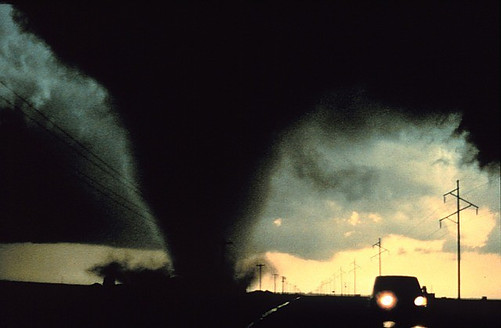
Tornadoes are extremely violent storms usually associated with very low atmospheric pressure and whirling winds. Their development commonly occurs when air at the surface has been warmed and a column of air descends from the cumulonimbus storm clouds above (see Pic #1). Air rushing into the low pressure area begins to fiercely rotate.
 Pic#1: Cumulonimbus
Pic#1: Cumulonimbus
Tornadoes are the most violent atmospheric phenomena and the most destructive over a relatively small area, when compared to other types of disasters like hurricanes or earthquakes. However, the affected area can be totally obliterated by winds that have been estimated to be as high as 385 mph (620 kph).
The diameter of the “twister” at ground level is usually ranges from 80 to 160 ft (25 – 50 m), but, within it, the destruction is enormous. Everything in its path, except for the most solid of structures, is sucked up into the air. The difference in pressure between the outside and inside of a structure is often the cause of its collapse (actually more like an explosion). Tornadoes can sound like a spinning top or engine and have been heard up to 25 miles (40 km) away. They travel at 30 – 40 mph (50 – 65 kph).
If a tornado occurs over the ocean, they are called “waterspouts”. Although they can occur elsewhere, tornadoes are most common over the prairie lands of the United States, especially in the Mississippi-Missouri valley. They also occur in Australia. Believe it or not, under the right conditions, tornadoes can develop into hurricanes.
Tornado Precautions
Take shelter in the most solid structure available – preferably reinforced concrete or steel-framed – if possible. But you should definitely look for either a storm cellar or a cave, if either one of these is available. These will offer the best possible protection.
If you are in a storm cellar, stay close to an outside wall, or in a specially reinforced section. If there is no basement, go to the center of the lowest floor, into a small room or shelter under sturdy furniture – but not where there is heavy furniture on the floor above you. Keep well away from any windows.
Firmly close all doors and windows in the direction of the oncoming wind and open all the door and windows on the other side. This will prevent the wind from coming in and lifting the roof as it approaches and will equalize the pressure to prevent the house from “exploding”.
Do NOT stay in a car, a van or any other mobile vehicle, they could be drawn up into the storm.
If you are outdoors you are vulnerable to flying debris and also to being lifted up – though there are reports of people being lowered again to the ground, unharmed. But, do you want to take that chance? You CAN see and hear a tornado coming. Get out of the way! Move at right angles to its apparent path. Take shelter in a ditch or depression in the ground, lie flat and cover your head with your arms.
Lightning
The release of electrical charge built up in clouds can be very dangerous, especially on high ground or when you are the tallest object in the area. In any kind of lightning storm stay away from hill brows, tall trees and lone boulders. Go to low, level ground and lie flat.
Insulation
If you are in a position where you can not get away from tall objects, but you have DRY material which will provide insulation, sit on it. For example, a dry coil of climbing rope makes good insulation. Rubber-soled shoes may make you a little more resistant, but it is not a guarantee that you will be safe.
Do NOT sit on anything wet. Bend your head down and hug your knees to your chest, lifting your feet off the ground and drawing in all your extremities. Do not reach down to the ground with your hands as that could make you the shortest path to ground and the lightning may take notice – much to your detriment. If you have nothing that will insulate you from the ground, lie as flat as possible.
Stay Low
Sometimes you can sense when lightning is about to strike by a tingling in the skin and the sensation of hair standing on end. If you are standing up, drop to the ground AT ONCE by going first to your knees and the hands touching the ground. If you should be struck, the charge may take the easiest path to ground – through your arms. This should prevent the lightning from going through your torso which could prevent heart failure or asphyxiation. QUICKLY LIE FLAT.
Do not hold metal objects when lightning is around and stay away from metal structures and fences. However, do not get rid of your equipment if you will lose all of it together (e.g. when climbing). A dry axe with a wooden handle may spark at the tip, but it is well insulated. Keep in mind that even close proximity to metallic objects and structures can be dangerous. Because, even without contact, the shock wave caused by the heated air of a lightning strike can cause damage to the lungs.
Shelter
One of the best places to seek shelter in a lightning storm is at least 3 ft (1 m) inside a deep cave with a minimum of 3 ft (1m) of space on either side of you. Do NOT shelter in the mouth of a cave or under a rock overhang in mountainous country. The lightning can spark across the gap. Small rock openings are frequently the ends of fissures which are also drainage routes and therefore automatic lightning channels.